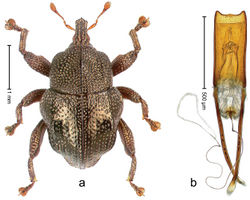Trigonopterus sinuatus
| Notice: | This page is derived from the original publication listed below, whose author(s) should always be credited. Further contributors may edit and improve the content of this page and, consequently, need to be credited as well (see page history). Any assessment of factual correctness requires a careful review of the original article as well as of subsequent contributions.
If you are uncertain whether your planned contribution is correct or not, we suggest that you use the associated discussion page instead of editing the page directly. This page should be cited as follows (rationale):
Citation formats to copy and paste
BibTeX: @article{Riedel2014ZooKeys, RIS/ Endnote: TY - JOUR Wikipedia/ Citizendium: <ref name="Riedel2014ZooKeys">{{Citation See also the citation download page at the journal. |
Ordo: Coleoptera
Familia: Curculionidae
Genus: Trigonopterus
Name
Trigonopterus sinuatus Riedel sp. n. – Wikispecies link – ZooBank link – Pensoft Profile
Diagnostic description
Holotype, male (Fig. 84a). Length 2.95 mm. Color of legs and head ferruginous; pronotum and elytron black with bronze lustre. Body in dorsal aspect with marked constriction between pronotum and elytron; in profile dorsally convex. Rostrum in apical half scabrous, coarsely punctate; in basal half with median and pair of submedian ridges; intervening furrows punctate, each with sparse row of erect setae; epistome with transverse, angulate ridge forming distinct median denticle. Pronotum with sides subparallel, anterolaterally rounded to subapical constriction; disk with pair of submedian impressions, coarsely punctate, reticulate; each puncture containing inconspicuous seta; with distinct median ridge. Elytra with humeri swollen, laterally projecting; interval 5 near middle with distinct tubercle dorsally projecting; interval 6 behind middle swollen, gently projecting from lateral outline; striae indistinct; intervals flat, punctate; at base and laterally densely coarsely punctate, remainder less densely punctate. Anteroventral ridge of femora distinct, in meso- and metafemur forming large tooth. Metafemur subapically with stridulatory patch. Dorsal edge of tibiae subbasally with angulation, in mesotibia with blunt tooth. Abdominal ventrite 5 flat, coarsely punctate. Penis (Fig. 84b) with sides of body subparallel; apex subtruncate, weakly angulate; transfer apparatus compact; apodemes 1.6 × as long as body; ductus ejaculatorius without bulbus. Intraspecific variation. Length 2.23–3.06 mm. Female body more slender. Female rostrum dorsally subglabrous, with submedian rows of punctures and sublateral pair of furrows; epistome simple. Female elytra subovate, without tubercles, lateral contour convex.
Material examined
Holotype (MZB): ARC1510 (EMBL # LM655608), West Nusa Tenggara Prov., Sumbawa, Batu Dulang, Mt. Batu Pasak, sample 2, S08°37.028', E117°15.783', 1305 m, 12-IV-2010. Paratypes (MZB, SMNK, ZSM): West Nusa Tenggara Prov., Sumbawa: 13 exx, ARC1509 (EMBL # LM655607), ARC1511 (EMBL # LM655609), ARC1512 (EMBL # LM655610), same data as holotype; 1 ex, Batu Dulang, Mt. Batu Pasak, sample 3, S08°37.524', E117°15.423', 1385 m, 12-IV-2010; 1 ex, Batu Dulang, Mt. Batu Pasak, sample 3, S08°37.524', E117°15.423', 1385 m, 18-IV-2010; 5 exx, ARC1493 (EMBL # LM655591), ARC1494 (EMBL # LM655592), ARC1495 (EMBL # LM655593), ARC1496 (EMBL # LM655594), Tepal, Pc. Nengas, sample 2, S08°35.884', E117°08.384', 1310 m, 15-IV-2010; 2 exx, Tepal, Pc. Nengas, sample 3, S08°35.386', E117°08.251', 1415 m, 15-IV-2010; 7 exx, Tepal, Pc. Nengas, sample 5, S08°35.740', E117°08.721', 1330 m, 16-IV-2010; 1 ex, Tepal, Pc. Nengas, sample 6, S08°35.533', E117°08.605', 1350 m, 16-IV-2010; 2 exx, Tepal, Pc. Nengas, sample 7, S08°35.176', E117°08.295', 1490 m, 16-IV-2010.
Distribution
West Nusa Tenggara Prov., Sumbawa (Batu Dulang, Tepal). Elevation: 1305–1490 m.
Etymology
This epithet is based on the Latin adjective sinuatus (bent) and refers to the elytral outline.
Notes
Trigonopterus sinuatus Riedel, sp. n. was coded as “Trigonopterus sp. 333” by Tänzler et al. (2014)[1]. Cox1 sequences of the populations from Tepal and Batu Dulang differ 15.7–16.0% p-distance, but morphologically no differences could be found.
Original Description
- Riedel, A; Tänzler, R; Balke, M; Rahmadi, C; Suhardjono, Y; 2014: Ninety-eight new species of Trigonopterus weevils from Sundaland and the Lesser Sunda Islands ZooKeys, (467): 1-162. doi
Images
|
Other References
- ↑ Tänzler R, Toussaint E, Suhardjono Y, Balke M, Riedel A (2014) Multiple transgressions of Wallace’s Line explain diversity of flightless Trigonopterus weevils on Bali. Proceedings of the Royal Society B: Biological Sciences 281: 20132528. doi: 10.1098/rspb.2013.2528
